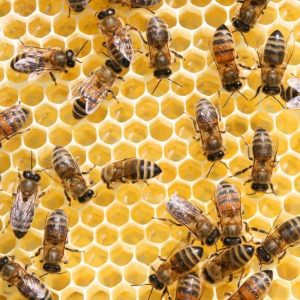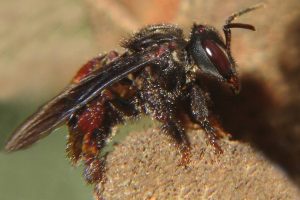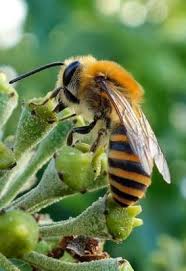Podcast: Play in new window | Download (Duration: 17:40 — 18.0MB)
Thanks to Linnea for suggesting bees! Obviously we can’t learn about ALL 20,000 bee species in this episode, but we’ll learn about the honeybee and some other interesting bees!
Further reading:
Bee friendly? Pollinating California’s almond crop
Western honeybees on a honeycomb:

A vulture bee thinking about “honey”:

The wholesome, solitary ivy bee:

Show transcript:
Welcome to Strange Animals Podcast. I’m your host, Kate Shaw.
It’s August and we’re kicking off a full month of our spineless friends! That’s right, it’s Invertebrate August, and to get us started, we’re going to learn about some really interesting bees. Thanks to Lynnea for the topic suggestion and some great links!
Bees live all over the world and there are thousands of species, something like 20,000 of them. The only place in the world that doesn’t have any bees is Antarctica, which doesn’t have much of anything.
When most of us think of bees, we think of the honeybee. The honeybee is one of the few invertebrates that are domesticated. People really like honey, and at some point humans realized that if they made pets of the bees that make honey, getting at the honey was a lot easier on both the people and the bees. We know that ancient Egyptians had already domesticated the western honeybee because there are tomb paintings of beekeepers and hives.
The honeybee is native to Europe and Asia, and there are about 30 species. The western honeybee is the most widespread. It lives in a structured colony with a queen, worker bees, and a few drones. The worker bees are all females but they don’t mate and lay eggs. Only the queen is fertile, and the drones are males who mate with the queen. Different worker bees have different roles in the hive. Some gather nectar and pollen from flowers, while some take care of the queen’s eggs and babies or build new honeycombs. All worker bees have stingers, which they use to defend the hive. Honeybees are striped yellow and black to warn other animals that they’re dangerous.
Worker bees make honey by partially digesting nectar, then spreading it in empty honeycomb cells to partially dry. When it’s the right consistency, the workers cap the cells. Honey is antibacterial and anti-fungal and will last pretty much forever in the hive. Eventually it will crystallize, though, and the bees will remove crystallized honey from the hive since they can’t eat it that way. Bees make honey to eat, and they need lots of it so they have extra for wintertime and bad weather when the bees stay inside.
In the wild, the honeybee builds its nest in crevices, such as a hollow tree or the rafters of your attic. Worker bees secrete wax from glands on the abdomen and use it to build honeycomb, which is a sheet of hexagonal cells. Hexagonal means six-sided, and each cell does have six sides. A hexagonal shape is the most efficient use of materials, since each side of the hexagon is shared with another cell instead of the bees having to make six sides for each cell. When they finish making one cell, they’ve already got one side made for six other cells that will adjoin that first cell, sort of like the walls separating rooms in your home.
The queen bee lays her eggs in honeycomb cells. An egg hatches into a larva and is fed by worker bees. All bee larvae get fed a secretion called royal jelly for the first three days after hatching. Royal jelly is high in protein. After three days, most larvae will only get fed a mixture of pollen and nectar called bee bread. The only exception is if the colony has eggs that are intended to grow into new queens. Queen bee larvae continue to get fed royal jelly, since they need the extra protein. The established queen bee of the hive also eats royal jelly.
Honeybees who live in an area with lots of flowers can produce so much honey that they completely fill up their hive. In domesticated bees, that’s when the beekeeper harvests the honey, and will usually return the emptied honeycombs to the hive for the bees to reuse. In bees living wild, if the colony stores so much honey that it’s running out of room for eggs, this will trigger a swarm. The queen leaves with about half the worker bees to find a new home. The workers who remain will continue to feed royal jelly to the newly hatched larvae, which means they develop into new queen bees. The workers have to modify the honeycomb cells for queen bees, which are bigger than other bees and don’t fit in an ordinary-sized cell.
The queen bee larvae pupate and metamorphose into mature bees. New queens chew an opening in their cells, which the worker bees have sealed shut, and each immediately fights all the other new queen bees. If one queen emerges before the others, she will kill the others before they have even finished metamorphosing.
The surviving queen takes over, but she can’t lay eggs that will develop into worker bees yet. She has to mate first. If you listened to episode 175 where we talked about flying ants, you’ll remember that in some species of ant, new queens have a nuptial flight where they mate with males, then store the sperm they collect to use for the rest of their life. Honeybees do this too. When weather conditions are right, the new queen will leave the hive and release pheromones that attract males from various hives in the area. A queen may have several nuptial flights before she has collected enough sperm, which she keeps in a special organ in her body. Then she returns to her hive to start laying eggs that will develop into new worker bees.
Bees are important as domesticated animals not just because we all like honey, but because bees are really good pollinators. The honeybee, and some other bees, have a structure often referred to as a pollen basket on the rearmost legs. It’s a sort of divot in the leg, like a built-in pocket, surrounded by hairs. As the bee crawls around on a flower collecting nectar, pollen sticks to its fuzzy body. The bee gives its front legs a lick and uses them to brush the pollen from its body, then presses the pollen into its pollen baskets. But, of course, it can’t get every grain of pollen off, and some of it rubs off onto the next flower’s stigma, pollinating it.
Some crops, like almonds, depend on beekeepers who bring hives of bees to each orchard in spring. The bees pollinate the almond flowers so they can develop into delicious almonds, which makes the orchard owners happy, and they collect lots of nutritious pollen, which makes the bees and beekeepers happy. Some beekeepers move their bee hives from place to place every spring to help farmers pollinate various crops, but the almond crop is a big deal since the California orchards produce more than 80% of the world’s almonds every year. Beekeepers depend on the money they receive from orchard owners to bring their bees to the orchards, and the orchard owners depend on those bees to make sure there are lots of almonds to harvest later in the year.
But increasingly, there aren’t enough honeybees to pollinate the expanding almond orchards. Colony Collapse Disorder has been known for over a century under various names, but it’s been on the increase since around 2006. A colony will be fine, and then suddenly almost all of the worker bees will just leave and never return. The queen and a few worker bees stay behind. It’s like the opposite of a swarm. It was once known as disappearing disease, but it doesn’t appear to be an actual disease that bees can catch.
Researchers still don’t know what precisely causes colony collapse. The bees left behind are healthy and the hive contains plenty of food. And the disorder doesn’t just happen in one place or one country, it’s happening all over, especially in North America, Europe, and Asia, where the western honeybee is most commonly kept by beekeepers.
It’s probable that a number of factors contribute to colony collapse, from pesticide use and climate change to declining biodiversity and known honeybee parasites and diseases. Researchers suggest that a colony that’s already under stress due to one or more of these factors is less healthy to start with, and the addition of another stress factor can cause worker bees to abandon the hive. Pesticides, herbicides, and fungicides seem to be major contributing factors.
Entomologists, beekeepers, almond farmers, and many others are working to learn more about what causes colony collapse disorder. In the meantime, they’re trying lots of things to improve bee health in general. Many almond farmers have stopped spraying insecticides on their trees until after the bees have finished pollinating the almond flowers, and those who do have to use insecticides make sure they use kinds that are minimally harmful to bees and then they only spray at night when the bees are safely in their hives. Some farmers have started growing weeds and other flowering plants near the almond trees to attract wild bees, which reduces their dependence on domesticated honeybees.
So do other species of bee produce honey? Nope, only honeybees produce honey. Oh, and the honey wasp. That’s right, there are a few species of wasp that produce honey that’s very similar to that made by honeybees. The wasps are native to Central and South America, with one species living in parts of southwestern North America. They prefer humid forests, including rainforests, and they make paper nests in trees the same way many other wasps do. They eat the honey but they also eat nectar and other insects. They’re actually beneficial to farmers since they eat lots of crop pests like boll weevils and leaf miners. They also help pollinate plants. But they are definitely not domesticated and they will sting you like whoa, and they also don’t produce very much honey compared to honeybees.
Most bees eat nectar and pollen, but will sometimes also eat juice from fruit they might happen to find. But the vulture bee eats meat from dead animals, just like a tiny vulture with six legs. It’s a tropical bee that lives in parts of North America, and not only is it related to the honeybee, it actually makes honey. Sort of. It’s not vegetarian honey, let’s put it that way.
There are three species of vulture bee, all of which have been known to science for centuries, but no one realized they ate meat until 1982. The vulture bee has also lost its pollen baskets, since it lives in areas where pollen is hard to come by. That’s why it eats meat instead, since it supplies the bees with protein in the absence of nutritious pollen.
If a vulture bee can’t find a dead animal to eat, it will sometimes sneak into wasp nests and eat young wasps. Since wasps often do the same thing to bees, that seems fair. Oh, and the vulture bee doesn’t have a sting.
The vulture bee’s mandibles have sharp tooth-like points that help them cut into meat. When a bee finds a dead animal, it will actually burrow into the carcass through its eyes. It also releases pheromones that help the other bees from its colony find the carcass. The bees can strip a carcass the size of, say, a big frog, in a few hours and will even chase flies away.
But the vulture bee can’t digest the meat, not as it is. It uses saliva mixed with nectar it’s eaten to break the meat down into a liquid, which it slurps up and brings back to the hive. Like honeybees partially digesting nectar, the vulture bee partially digests the liquefied meat, which mixes it with enzymes from the bee’s body. Then it regurgitates the liquid to dry in honeycomb cells until it has the consistency of honey, which it is. But I would not eat it.
It turns out that when a bee larva pupates, it spins a cocoon. Even honeybees and other social bees do this, despite the fact that they pupate in cozy little hexagonal cells. And it turns out that the silk that social bees and ants spin to make the cocoon is very different from spider and moth silk. The proteins that make up the silk consist of coiled strands that are also coiled around each other, making the silk incredibly strong but still light-weight. Spider and moth silk is much smoother since it’s made up of a larger protein that is sort of a sheetlike structure.
Since there are so many species of bee in the world, there’s simply no way I can do more than scratch the surface of knowledge and this episode is already getting long. We haven’t even talked about mason bees, and I’d planned to focus on them this time but got sidetracked by honeybees! We’ll save mason bees for another time, but let’s finish up with a solitary bee—that is, a type of bee that doesn’t live in colonies.
The ivy bee lives throughout much of Europe, including the UK, and is a fairly large bee. The female grows to around 13 millimeters long on average although males are smaller. At first glance it looks like a big honeybee but has more vivid black and yellow-orange stripes on its abdomen. If you remember episode 160, where we talked about the Osima avosetta bee that makes her nest out of flower petals, the ivy bee will seem familiar to you. The female digs little nests in the ground to lay her eggs in, one egg per nest, and she leaves nectar and pollen for the babies to eat when they hatch. Then the larvae pupate and emerge as adults in late summer.
The ivy bee gets its name because it mostly eats the pollen and nectar of the ivy plant, which flowers in autumn. Hundreds of ivy bees may swarm over a bank of ivy but they’re not dangerous at all. The bees help pollinate the ivy flowers, which in turn means that there will be plenty of ivy berries in winter for birds to eat. The birds eat the berries but poop out the seeds, which means more ivy will grow. Teamwork!
Quite often you’ll hear people talk about saving the bees, and that’s important. Wild bees of all kinds are declining in number due to habitat loss and pesticides. The best thing you can do to help is to plant flowers, especially flowers native to your area. Even if you can only plant a small flower garden, you will definitely be helping your local wild bees—and butterflies, moths, and other beneficial insects. Teamwork again! You can be part of the bee team!
You can find Strange Animals Podcast online at strangeanimalspodcast.blubrry.net. That’s blueberry without any E’s. If you have questions, comments, or suggestions for future episodes, email us at strangeanimalspodcast@gmail.com. If you like the podcast and want to help us out, leave a rating and review on Apple Podcasts or wherever you listen to podcasts. We also have a Patreon at patreon.com/strangeanimalspodcast if you’d like to support us that way.
Thanks for listening!